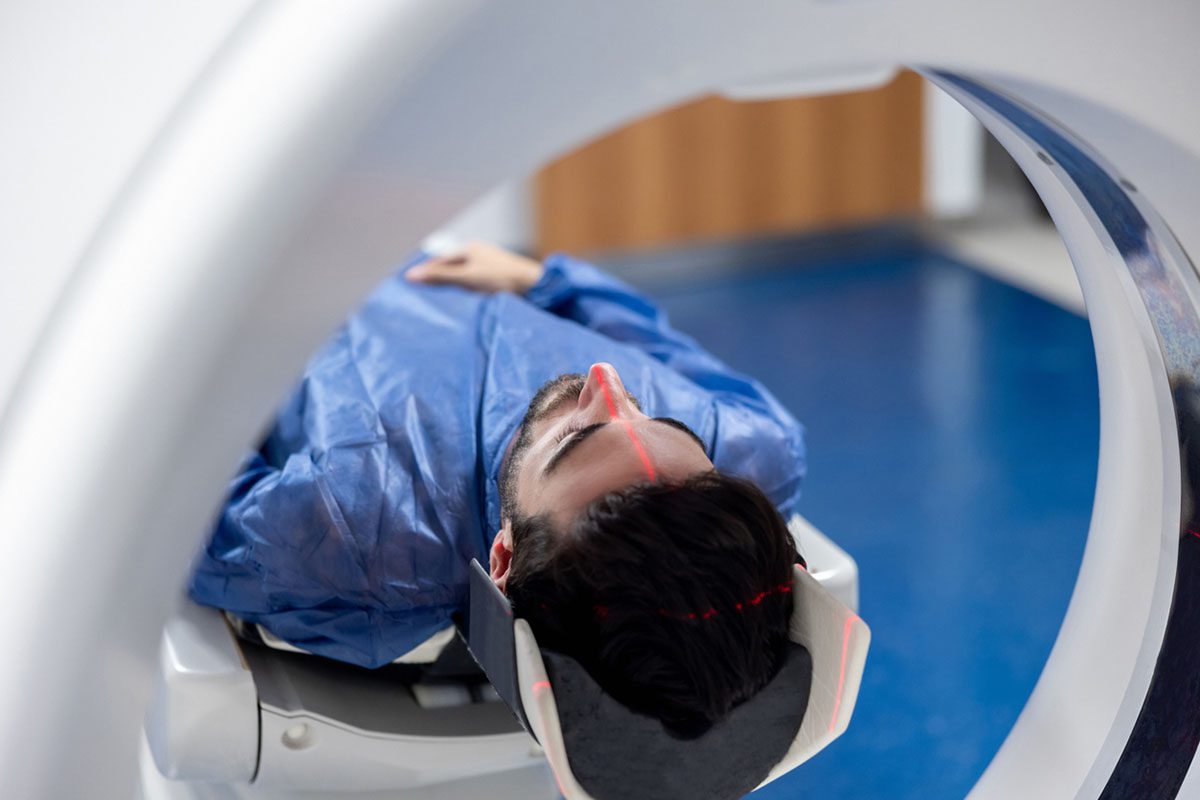

Crying But Not Depressed:
A Case of Poststroke Emotionalism
Emotional disturbances are common among stroke survivors.1 Poststroke emotional incontinence (PSEI) is a state of excessive and inappropriate crying or laughter with no visible stimuli or in response to stimuli that would not commonly provoke such a reaction. Episodes are sudden, uncontrollable, and may or may not be mood congruent.2 PSEI has a reported prevalence ranging from 6%-34%, with a severe impact on the individual’s quality of life.3,4 As it happens with other neuropsychiatric manifestations of poststroke conditions, like depression or anxiety, PSEI often goes undiagnosed and neglected.2 Here, we present a case in which a patient with PSEI was diagnosed as severely depressed.
Case Report
Mr A is a 67-year-old patient referred to the geriatric psychiatry outpatient clinic by his cardiologist for severe depression. During the clinical interview, we found that the patient was hospitalized for an ischemic stroke located in the right capsular and thalamic regions in December 2017. A month after discharge, he developed episodes of uncontrollable crying. At follow-up after his stroke in March 2018, Mr A was considered depressed by his internal medicine doctor, who then prescribed escitalopram 10 mg. As the patient showed no improvement, at the follow-up consultation in June 2018, his doctor increased the dose to 20 mg. As there was suspicion of cardiomyopathy, the patient was referred for a cardiology appointment, at which he presented with crying outbursts.
In September 2018 at his appointment in the geriatric outpatient clinic, Mr A presented with dramatic emotional incontinence, crying after any small stimuli ranging from the conventional courteous manners to the mentioning of his family. Mr A’s affect was mostly inappropriate to the mood and situation, as he denied being depressed. He admitted feeling depressed shortly after the stroke but denied being depressed for several months now. We did not submit the patient to a structured diagnostic interview but informally assessed several items required for the diagnosis of major depressive disorder according to the DSM-5. As such, although the patient reported that he often wondered why the stroke happened to him, he denied recently experiencing a low mood. He also denied loss of pleasure in daily activities, as well as psychomotor, concentration, sleep, or appetite changes. He reported no feelings or thoughts of hopelessness or suicidal ideation. He had no loss of functionality. He confirmed, however, that he was upset with not being able to control his crying and bothered with the unwanted attention from family and friends, as they thought he was severely depressed. He was also frustrated with being unable to explain that he was not depressed. Concordance between the patient and his daughter-in-law regarding the inappropriateness of crying outbursts established the diagnosis of PSEI according to the criteria defined by Kim and Choi-Kwon.5 When asked if he was taking his medication properly, Mr A restated several times that he was and had been since it was prescribed, which was further confirmed by his daughter-in-law. There was no report of episodes of inappropriate laughter.
Since escitalopram 20 mg was not reducing Mr A’s PSEI symptoms, we opted to suspend it and initiate sertraline 50 mg in cross-titration. We assessed the patient 1 month later. At reassessment, he reported noticeable improvement, which was demonstrated by not crying once during the interview.
Discussion
Both emotional incontinence and depression may emerge as poststroke conditions.2 In poststroke depression, crying occurs as a manifestation of a more pervasive and sustained state. In PSEI, crying arises as an involuntary and sudden outburst that is experienced as disproportionate to a given situation. Although they may coexist, PSEI and poststroke depression are 2 different phenomena and should be identified as such.
Pharmacotherapy for emotionalism after stroke relies mostly on serotoninergic agents.6 Selective serotonin reuptake inhibitors as a class are considered a first-line pharmacologic intervention. Fluoxetine, sertraline, and citalopram have proved to be effective in randomized controlled trials.2 Other agents, such as serotonin-norepinephrine reuptake inhibitors, could also be valuable. As such, the challenge lies in choosing an agent that meets the patient’s needs.
Due to its long half-life, fluoxetine may be the right choice for patients who sometimes forget to take their medication. Sertraline or escitalopram may be effective in polymedicated patients since their interaction profile is benign. On the other hand, fluvoxamine has an extensive list of potential interactions, which may be problematic in heavily medicated patients. Escitalopram and citalopram could cause a problem in patients with cardiovascular conditions due to their QT interval prolongation properties. Stroke survivors, especially those with thalamic lesions, may present with pain syndromes.7 In these cases, venlafaxine or duloxetine should be given consideration due to their noradrenergic actions, which could be useful in relieving pain.
Despite the recognition that patients with PSEI merit therapeutic action, there is a lack of information on how to longitudinally manage the intervention. Literature has yet to address issues such as inadequate response or treatment duration. Further studies are necessary to help guide timely treatment adjustments and management.
This case highlights the need for careful identification of PSEI, which may not be accompanied by depression. It also notes the necessity to thoroughly assess the patient’s symptoms to tailor PSEI pharmacotherapy. Such assessment seems relevant if the significant impact of stroke on the global burden of disease is considered.8
Published online: September 19, 2019.
Potential conflicts of interest: None.
Funding/support: None.
Patient consent: Consent was received from the patient to publish this case report, and information has been de-identified to protect anonymity.
REFERENCES
1.Hackett ML, Köhler S, O’ Brien JT, et al. Neuropsychiatric outcomes of stroke. Lancet Neurol. 2014;13(5):525-534. PubMed CrossRef
2.Kim JS. Post-stroke mood and emotional disturbances: pharmacological therapy based on mechanisms. J Stroke. 2016;18(3):244-255. PubMed CrossRef
3.Chen YK, Wong KS, Mok V, et al. Health-related quality of life in patients with poststroke emotional incontinence. Arch Phys Med Rehabil. 2011;92(10):1659-1662. PubMed CrossRef
4.Choi DH, Jeong BO, Kang HJ, et al. Psychiatric comorbidity and quality of life in patients with post-stroke emotional incontinence. Psychiatry Investig. 2013;10(4):382-387. PubMed CrossRef
5.Kim JS, Choi-Kwon S. Poststroke depression and emotional incontinence: correlation with lesion location. Neurology. 2000;54(9):1805-1810. PubMed CrossRef
6.Kim JS. Management of post-stroke mood and emotional disturbances. Expert Rev Neurother. 2017;17(12):1179-1188. PubMed CrossRef
7.Klit H, Finnerup NB, Jensen TS. Central post-stroke pain: clinical characteristics, pathophysiology, and management. Lancet Neurol. 2009;8(9):857-868. PubMed CrossRef
8.Feigin VL, Norrving B, Mensah GA. Global burden of stroke. Circ Res. 2017;120(3):439-448. PubMed CrossRef
aPsychiatry and Mental Health Department, Leiria Hospital Centre, Leiria, Portugal
*Corresponding author: Sérgio M. Martinho, MD, Serviço de Psiquiatria e Saúde Mental, Centro Hospitalar de Leiria, Rua das Olhalvas, 2410-196, Leiria, Portugal ([email protected]).
Prim Care Companion CNS Disord 2019;21(5):18l02418
To cite: Martinho SM, Poças A. Crying but not depressed: a case of poststroke emotionalism. Prim Care Companion CNS Disord. 2019;21(5):18l02418.
To share: https://doi.org/10.4088/PCC.18l02418
© Copyright 2019 Physicians Postgraduate Press, Inc.
Please sign in or purchase this PDF for $40.00.




